Forum Discussion
136 Replies
wapiticountry wrote:
JRscooby wrote:
Additional revenue streams are often way over-rated. You have many variables to consider before it makes sense to add an amenity even if you can charge for it. To start with, how much does it cost and how much can you charge? The history of posts in these forums often indicate the service should be free and used to attract additional customers. Many parks I know are turning away reservations because they are full so that model surely isn’t profitable. And regardless of what some people post, adding any electrical service isn’t free and you cannot just add loads to wiring because at some point I he circuits will overload and trip. EV charging is going to require parks to change their electrical infrastructure and that will involve excavation since every park I am familiar with has underground wiring to the sites . And when you install that new wiring it has to cross roads, other utilities and parking pads. It gets real expensive very quickly.monkey44 wrote:
Can someone explain to me the actual time in minutes or hours, whatever. How long is a 'fast charge'. Assume you have a three quarters batter discharge on a trip. How long does it take to recharge that battery.
People keep saying fast charge and quick charge which no definition in time.
Not to argue 'gas vs electric', just comparing time to fill tank vs time to charge when you are on a trip that's more miles than a battery will take you and you need a charge somewhere, wherever that exists.
I would enjoy a reply to that myself.
Once we pulled into a fuel stop right behind a Tesla. She plugged in while my DW headed to restroom, and I walked the dog around the rig touching tires and hubs. Wife came out, I pulled over to pump, filled. Wife and dog had got back to pickup, so she moved it back to edge of PL while I restroom and got some snacks. I noticed the Teslas where eating. We ate chips and left. About 20 miles down the road that Tesla passed us. I have no idea what state of charge was when arrived or left. Maybe they just got enough to get somewhere cheaper?
I would think that for a few years, most EVs in CGs will be toads, or travelers stopping for charge and picnic. That would be a revenue stream for the owners.
Then you have to consider if adding an amenity, no matter how profitable, brings in a desirable customer. If it becomes common knowledge RV parks have charging stations will that draw a bunch on EV owners, sans RVs who wish to charge? That would be an unwanted development for most parks. They don’t want people who aren’t staying at the park walking the grounds, using the restrooms and playing in the playgrounds while they wait for the charge to finish, no matter how much they could charge. I believe the vast majority of parks are going to just wait and be followers rather than being at the forefront of EVs.
Other than some sort of emergency I can't imagine any EV owner going to an RV park to charge on a level 2 charger. A level 3 DC fast charger is a MUCH better and probably 5 to 50 times faster.
As indicated earlier basic EV charging services can be offered with zero investment. Its a no brainer for a campground owner to take advantage of that.
JMHOmonkey44 wrote:
Can someone explain to me the actual time in minutes or hours, whatever. How long is a 'fast charge'. Assume you have a three quarters batter discharge on a trip. How long does it take to recharge that battery.
People keep saying fast charge and quick charge which no definition in time.
Not to argue 'gas vs electric', just comparing time to fill tank vs time to charge when you are on a trip that's more miles than a battery will take you and you need a charge somewhere, wherever that exists.
Here are a few pics for clarity and reference.
This first pic is what comes with any Tesla but its pretty much the same as any other manufacturer. Tesla uses a different shaped plug but the same J1772 as all other EVS. All EVSE's are compatible with all EV's although you may need a small adapter if a Tesla is involved. This one is in my garage.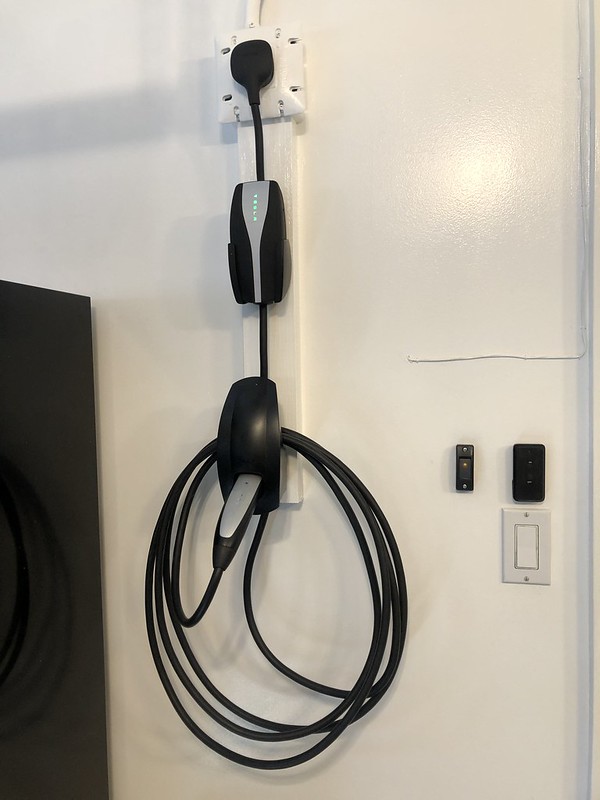
A little bigger pic for context. This is the unit in my garage. Standard 32 amp 240 volt (but adjustable in the car). You can see it is plugged into a standard 14-50 Nema 50 amp receptacle you would find in any campground with 50 amp service. Some retailers call these "quick chargers". They are not. They are essentially an extension cord that follows J1772 safety protocols for EV's. This is what every EV carries and would be plugging into the 50 amp service at a campground.
Here is another one. Same thing. But this is integrated into an RV pedestal. This is the product that KOA is installing in their campgrounds. Rumour has it they are 40 amp units but this hasn't been confirmed. These are useable by every brand of EV made today.
Here is another one. This one is in my driveway. If a campground wanted to install their own EVSE's in a separate parking spots they would probably go with something like this. This one is a little small though. It only provides 12 amps at 240 volts. Our house only has 100 amp service so our second unit is smaller. Its also hardwired so tough to steal. L2 (level 2) charging can be as little as 12 amps 240 volts and as high as 80 amps 240 volts, depending what the feed and equipment is. This is a little guy but its actually our most used charge station as quite often I park outside when I am working on projects in my garage.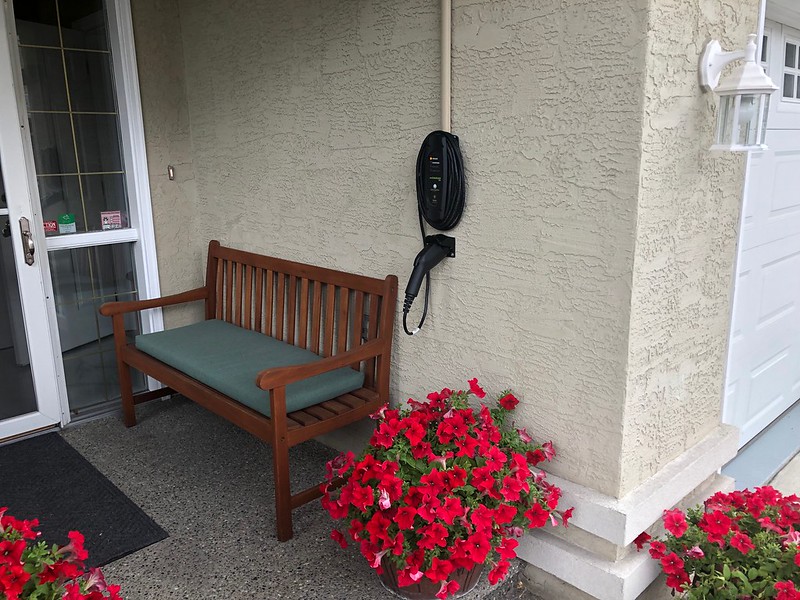
And a little wider shot for context. When "fueling at home, driving isn't just cheap, its stupid cheap.
This is a typical Supercharger co-located at a Petro Canada. These are pretty much the same as any other DC fast charger but they are private for use of Tesla owners only. They use a different connector for a variety of reasons we won't get into here, but suffice to say they are just a private DC fast charger. Sometimes they are co-located with public fast chargers. Tesla has been doing that a lot in BC lately.
Here is a public and private DC fast charger site. This is a Flying J. These combined sites are getting common up here. Tesla is contracted to do the install because they do so many but the public chargers are owned and operated by FLO.
Another Flying J.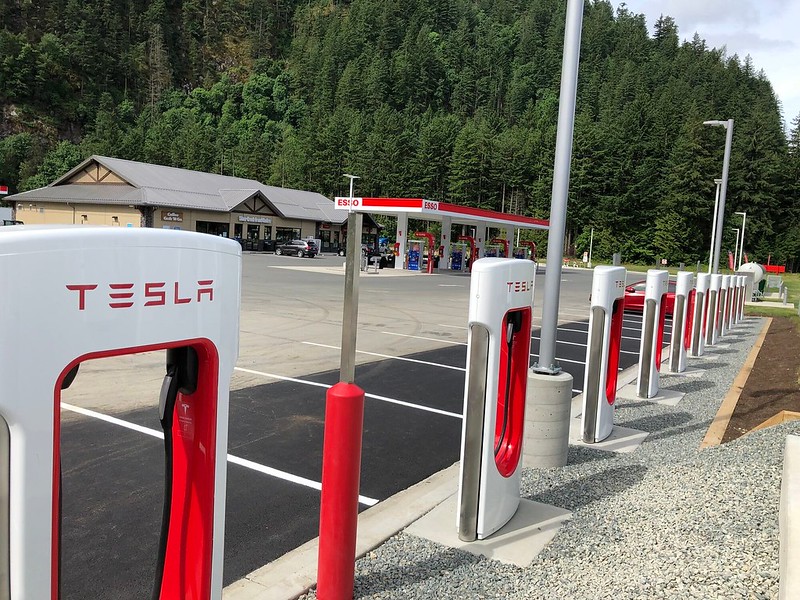
This is one of the problems those of us with electric tow vehicles face. Many (read most) of the earlier DC fast chargers were built with no way to charge without blocking a couple chargers. Ugh. Its getting better...slowly.
This is a pull thru that FLO put in about 70 kilometres away from us. Better.
These newer double sites work but just like a gas pump island they block the second "pump".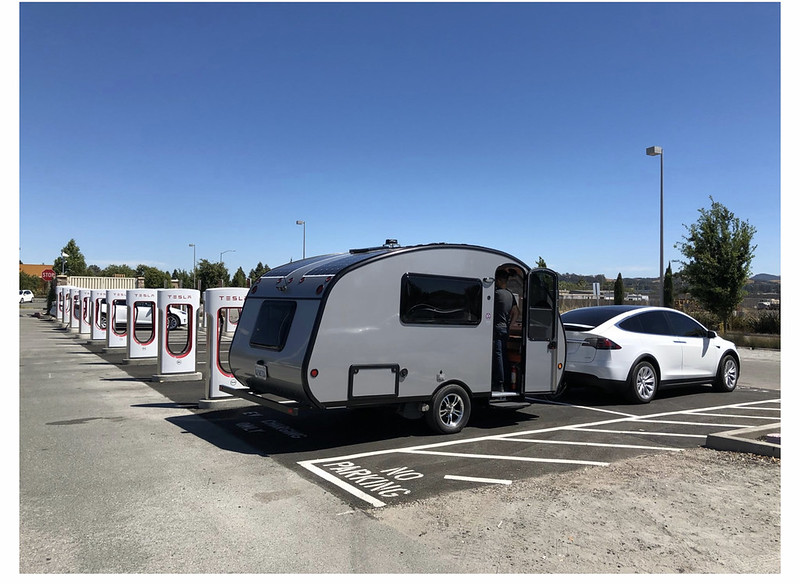
Unfortunately by far these older back in configurations are still predominant out there. If you are towing you'll be either unhooking or taking up 2 or 3 spots. People are pretty good though and tend to shuffle to make it happen. Us early adapters are a patient bunch. :)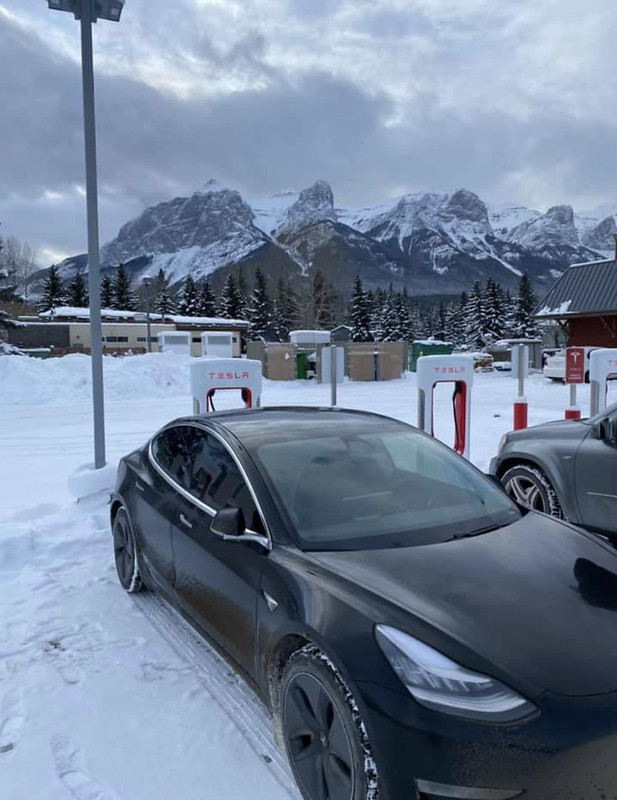 Untitled by radar231, on Flickr
Untitled by radar231, on Flickr
Hope that these pictures give some context.
Not an expert.
Cheers.- wapiticountryExplorer
JRscooby wrote:
Additional revenue streams are often way over-rated. You have many variables to consider before it makes sense to add an amenity even if you can charge for it. To start with, how much does it cost and how much can you charge? The history of posts in these forums often indicate the service should be free and used to attract additional customers. Many parks I know are turning away reservations because they are full so that model surely isn’t profitable. And regardless of what some people post, adding any electrical service isn’t free and you cannot just add loads to wiring because at some point I he circuits will overload and trip. EV charging is going to require parks to change their electrical infrastructure and that will involve excavation since every park I am familiar with has underground wiring to the sites . And when you install that new wiring it has to cross roads, other utilities and parking pads. It gets real expensive very quickly.monkey44 wrote:
Can someone explain to me the actual time in minutes or hours, whatever. How long is a 'fast charge'. Assume you have a three quarters batter discharge on a trip. How long does it take to recharge that battery.
People keep saying fast charge and quick charge which no definition in time.
Not to argue 'gas vs electric', just comparing time to fill tank vs time to charge when you are on a trip that's more miles than a battery will take you and you need a charge somewhere, wherever that exists.
I would enjoy a reply to that myself.
Once we pulled into a fuel stop right behind a Tesla. She plugged in while my DW headed to restroom, and I walked the dog around the rig touching tires and hubs. Wife came out, I pulled over to pump, filled. Wife and dog had got back to pickup, so she moved it back to edge of PL while I restroom and got some snacks. I noticed the Teslas where eating. We ate chips and left. About 20 miles down the road that Tesla passed us. I have no idea what state of charge was when arrived or left. Maybe they just got enough to get somewhere cheaper?
I would think that for a few years, most EVs in CGs will be toads, or travelers stopping for charge and picnic. That would be a revenue stream for the owners.
Then you have to consider if adding an amenity, no matter how profitable, brings in a desirable customer. If it becomes common knowledge RV parks have charging stations will that draw a bunch on EV owners, sans RVs who wish to charge? That would be an unwanted development for most parks. They don’t want people who aren’t staying at the park walking the grounds, using the restrooms and playing in the playgrounds while they wait for the charge to finish, no matter how much they could charge. I believe the vast majority of parks are going to just wait and be followers rather than being at the forefront of EVs. monkey44 wrote:
Can someone explain to me the actual time in minutes or hours, whatever. How long is a 'fast charge'. Assume you have a three quarters batter discharge on a trip. How long does it take to recharge that battery.
People keep saying fast charge and quick charge which no definition in time.
Not to argue 'gas vs electric', just comparing time to fill tank vs time to charge when you are on a trip that's more miles than a battery will take you and you need a charge somewhere, wherever that exists.
Depends. So many variables. A typical supercharger stop for a sedan like ours is 15 to 20 minutes on a V3 250 kw supercharger. But that’s because most of us hit the road before 90 percent as charging slows down a lot after that. 3 hours later rinse and repeat.
Trucks? Who knows. Those are bigger batteries and none of the manufacturers have indicated what speeds they will charge at. Theoretically big batteries could take advantage of the 350 kw electrify American chargers but who knows what rate they will charge at. Right now Tesla peak out at 250 kw but that’s typically below 40 percent charge. It tapers after that. Think we’ll all have to wait. Suffice to say it will be quite a bit slower than diesel or gas. If that’s someone’s number one performance criteria I would say gas or diesel is the way to go.
Unofficially fast charging and quick charging are two different things. Retailers sometimes refer to higher current L2 EVSE’s (charge stations) as quick chargers. These are the charge stations that people install in their homes. They are not chargers. They are essentially a fancy extension cord with a bunch of safety protocols that connects AC current to the cars built in chargers.
The term fast charger refers to a DC fast charger. Here the big gas pump looking thing delivers DC current directly to the battery at up to 350 kw ( and as low as 25 kw although those are rare).
I’ll put some pictures up later.monkey44 wrote:
Trouble is Level 3 DC charging has a wide variation from 25 kW to maybe 350 kW. Each vehicle also has a maximum. And the charging tapers starting at maybe 50% full depending on the rate, battery size, temperature.
Can someone explain to me the actual time in minutes or hours, whatever. How long is a 'fast charge'. Assume you have a three quarters batter discharge on a trip. How long does it take to recharge that battery.
Really hard to give a definitive answer. Even the vehicle specification would be under ideal conditions.
Either way L3 is always faster than L2 that would take overnight for a fill up from 75% discharged.- JRscoobyExplorer II
monkey44 wrote:
Can someone explain to me the actual time in minutes or hours, whatever. How long is a 'fast charge'. Assume you have a three quarters batter discharge on a trip. How long does it take to recharge that battery.
People keep saying fast charge and quick charge which no definition in time.
Not to argue 'gas vs electric', just comparing time to fill tank vs time to charge when you are on a trip that's more miles than a battery will take you and you need a charge somewhere, wherever that exists.
I would enjoy a reply to that myself.
Once we pulled into a fuel stop right behind a Tesla. She plugged in while my DW headed to restroom, and I walked the dog around the rig touching tires and hubs. Wife came out, I pulled over to pump, filled. Wife and dog had got back to pickup, so she moved it back to edge of PL while I restroom and got some snacks. I noticed the Teslas where eating. We ate chips and left. About 20 miles down the road that Tesla passed us. I have no idea what state of charge was when arrived or left. Maybe they just got enough to get somewhere cheaper?
I would think that for a few years, most EVs in CGs will be toads, or travelers stopping for charge and picnic. That would be a revenue stream for the owners. - monkey44Nomad IICan someone explain to me the actual time in minutes or hours, whatever. How long is a 'fast charge'. Assume you have a three quarters batter discharge on a trip. How long does it take to recharge that battery.
People keep saying fast charge and quick charge which no definition in time.
Not to argue 'gas vs electric', just comparing time to fill tank vs time to charge when you are on a trip that's more miles than a battery will take you and you need a charge somewhere, wherever that exists. - 8_1_VanExplorer
With an exterior made of scratch- and dent-resistant stainless steel, a towing capacity of up to 14,000 pounds, and a driving range of 500-plus miles, Tesla’s all-electric Cybertruck certainly has the ability to rival any top-selling pickup truck on the market.
Cybertruck towing capacity - deleted
About Travel Trailer Group
44,046 PostsLatest Activity: Aug 01, 2025